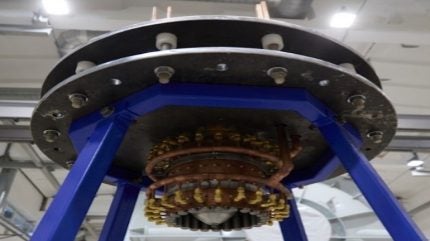
Rosatom scientists have developed a laboratory prototype for a plasma electro-reactive rocket engine based on a magnetic plasma accelerator with elevated traction parameters (at least 6 Newtons) and specific impulse (at least 100 km/s). The work was carried out as part of a comprehensive programme for the development of atomic science, technology and technology in Russia, which in 2025 became part of the national project, New Nuclear & Energy Technologies.
The average power of such an engine operating in pulse periodic mode reaches 300 kW, enabling spacecraft to achieve speeds beyond the reach of chemical engines, and also allowing efficient use of fuel, reducing its demand tenfold.
“Currently the flight to Mars using ordinary engines can take almost a year in one direction, which is dangerous for astronauts due to cosmic radiation exposure,” said Alexei Voronov, First Deputy General Director for Science at the Troitsk Institute of Innovative & Thermonuclear Research (Triniti – Triotskii Institut Innovatsionnikh i Termoyalernikh Issledovanii), part of Rosatom’s scientific division. “The use of plasma engines can reduce the mission to 30-60 days making it possible to send the astronaut to Mars and back. The creation of a prototype is one of the most important stages of the project, since it determines whether such an engine will be suitable for “nuclear tugs” in space and whether it will be possible to reduce the costs of their production overall,” he added.
To test the prototype of the plasma rocket engine and similar devices on the site in Troitsk, a large -scale experimental stand has been installed at Triniti. The diameter of the key equipment of the stand – the vacuum chamber – is 4 metres with a length of 14 metres. It is equipped with unique systems for high -performance vacuum pumping and heat removal.
Rosatom specialists, within the framework of the national space exploration programme, participate in the development of new nuclear power plants for various purposes, including to provide energy to transport and research spacecraft, as well as equipment and systems for bases located on the surface of other planets. On-board systems and automatic control and navigation systems for spacecraft are manufactured by the Moscow Experimental Design Bureau MOKB (Moskovskoye Opytno-Konstruktorskoye Byuro) Mars, which develops on-board control systems for the Arctic-M spacecraft series and weather satellite Electro-L.
The All Russian Scientific Research Institute of Experimental Physics (VNIIEF – Vsorosiiskii Nauchno-Isslodovatelskii Institut Eksperimentalnoi in Sarov and MOKB Mars have developed a control system for the Spektr RG space observatory and participated in the development of telescopes. Spektr-RG is a Russian-German high-energy astrophysics space observatory launched in 2019. In 2024, a team of scientists, including two from VNIIEF, received awards for the creation of the first Russian ART-XC x-ray telescope installed on board Spektr RG. VNIIEF is also developing equipment for space laser communications, which will transmit information up to 45,000 km from Earth to low-orbit satellites.
In addition, specialists at the Institute of Physical and Technical Problems (IFTP – Institut Fiziko-Tekhnicheskikh Problem has developed a unique gamma-ray installation capable of reproducing space radiation. This makes it possible to test electronic components in conditions as close as possible to those in space. Another enterprise – the Specialised Research Institute of Instrument Engineering (SNIIP – Spetsializirovannii Nauchno-Issledovatelskii Institut Priborostroyeniya) devised the Matryoshka module which records the effect of cosmic radiation on the human body. For 20 years, it has recorded the distribution of dose loads in various International Space Station compartments.






